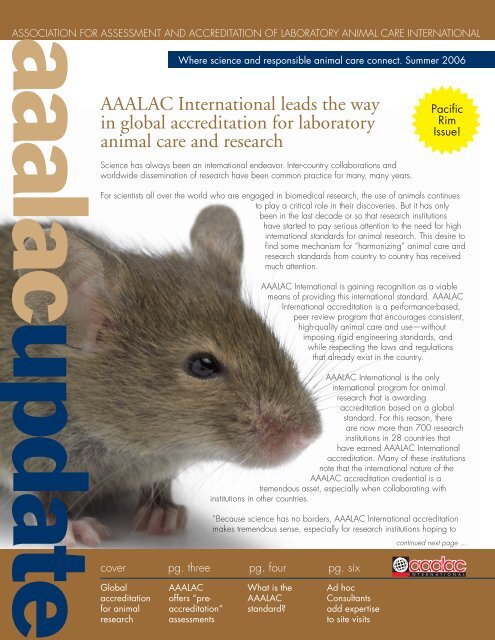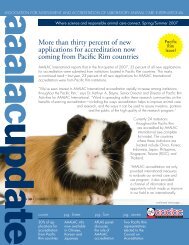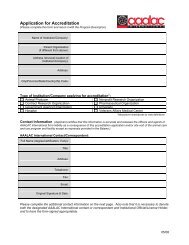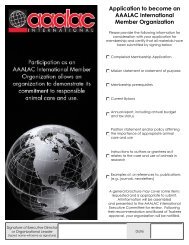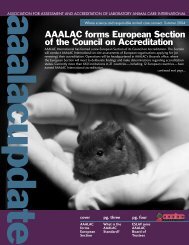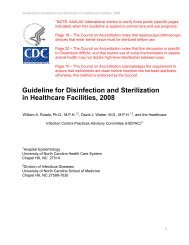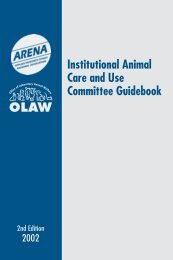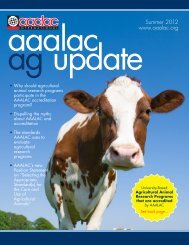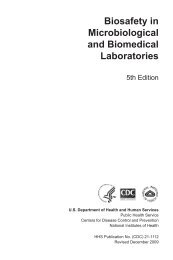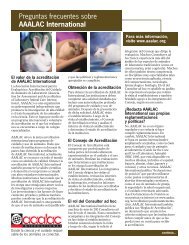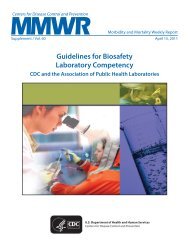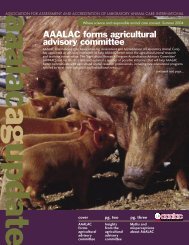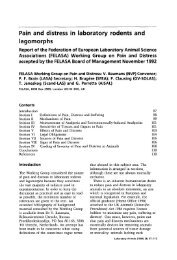AAALAC International leads the way in global accreditation for ...
AAALAC International leads the way in global accreditation for ...
AAALAC International leads the way in global accreditation for ...
You also want an ePaper? Increase the reach of your titles
YUMPU automatically turns print PDFs into web optimized ePapers that Google loves.
Association <strong>for</strong> Assessment and Accreditation of Laboratory Animal Care <strong>International</strong>aaalacupdateGlobal<strong>accreditation</strong><strong>for</strong> animalresearchWhere science and responsible animal care connect. Summer 2006<strong>AAALAC</strong> <strong>International</strong> <strong>leads</strong> <strong>the</strong> <strong>way</strong><strong>in</strong> <strong>global</strong> <strong>accreditation</strong> <strong>for</strong> laboratoryanimal care and researchScience has al<strong>way</strong>s been an <strong>in</strong>ternational endeavor. Inter-country collaborations andworldwide dissem<strong>in</strong>ation of research have been common practice <strong>for</strong> many, many years.For scientists all over <strong>the</strong> world who are engaged <strong>in</strong> biomedical research, <strong>the</strong> use of animals cont<strong>in</strong>uesto play a critical role <strong>in</strong> <strong>the</strong>ir discoveries. But it has onlybeen <strong>in</strong> <strong>the</strong> last decade or so that research <strong>in</strong>stitutionshave started to pay serious attention to <strong>the</strong> need <strong>for</strong> high<strong>in</strong>ternational standards <strong>for</strong> animal research. This desire tof<strong>in</strong>d some mechanism <strong>for</strong> “harmoniz<strong>in</strong>g” animal care andresearch standards from country to country has receivedmuch attention.cover pg. three pg. four pg. six<strong>AAALAC</strong>offers “pre<strong>accreditation</strong>”assessments<strong>AAALAC</strong> <strong>International</strong> is ga<strong>in</strong><strong>in</strong>g recognition as a viablemeans of provid<strong>in</strong>g this <strong>in</strong>ternational standard. <strong>AAALAC</strong><strong>International</strong> <strong>accreditation</strong> is a per<strong>for</strong>mance-based,peer review program that encourages consistent,high-quality animal care and use—withoutimpos<strong>in</strong>g rigid eng<strong>in</strong>eer<strong>in</strong>g standards, andwhile respect<strong>in</strong>g <strong>the</strong> laws and regulationsthat already exist <strong>in</strong> <strong>the</strong> country.<strong>AAALAC</strong> <strong>International</strong> is <strong>the</strong> only<strong>in</strong>ternational program <strong>for</strong> animalresearch that is award<strong>in</strong>g<strong>accreditation</strong> based on a <strong>global</strong>standard. For this reason, <strong>the</strong>reare now more than 700 research<strong>in</strong>stitutions <strong>in</strong> 28 countries thathave earned <strong>AAALAC</strong> <strong>International</strong><strong>accreditation</strong>. Many of <strong>the</strong>se <strong>in</strong>stitutionsnote that <strong>the</strong> <strong>in</strong>ternational nature of <strong>the</strong><strong>AAALAC</strong> <strong>accreditation</strong> credential is atremendous asset, especially when collaborat<strong>in</strong>g with<strong>in</strong>stitutions <strong>in</strong> o<strong>the</strong>r countries.“Because science has no borders, <strong>AAALAC</strong> <strong>International</strong> <strong>accreditation</strong>makes tremendous sense, especially <strong>for</strong> research <strong>in</strong>stitutions hop<strong>in</strong>g toWhat is <strong>the</strong><strong>AAALAC</strong>standard?Ad hocConsultantsadd expertiseto site visitsPacificRimIssue!cont<strong>in</strong>ued next page ...
Summer 2006collaborate with scientists <strong>in</strong> o<strong>the</strong>r countries,” says John G.Miller, D.V.M., Executive Director of <strong>AAALAC</strong> <strong>International</strong>.“Earn<strong>in</strong>g <strong>AAALAC</strong> <strong>accreditation</strong> provides an assurancethat certa<strong>in</strong> quality standards are be<strong>in</strong>g met from <strong>in</strong>stitutionto <strong>in</strong>stitution, and from country to country.”More <strong>in</strong><strong>for</strong>mation on apply<strong>in</strong>g <strong>for</strong> <strong>AAALAC</strong> <strong>International</strong><strong>accreditation</strong> can be found onl<strong>in</strong>e at www.aaalac.org.•Pacific Rim countries/localeswith accredited programsThis list <strong>in</strong>cludes <strong>the</strong> year <strong>in</strong> which an organization <strong>in</strong> eachcountry first earned <strong>AAALAC</strong> <strong>International</strong> <strong>accreditation</strong> …Philipp<strong>in</strong>es 1995Indonesia 1996Korea 1998Thailand 1999Taiwan, R.O.C. 2000Hong Kong 2005Japan 2005Peoples Republic of Ch<strong>in</strong>a 2006Institutions currently accreditedby <strong>AAALAC</strong> <strong>International</strong> <strong>in</strong>clude:Development Center <strong>for</strong> BiotechnologyXizhi City, Taipei CountyTAIWAN/R.O.C.INA Research Inc.INA Research Inc., Test<strong>in</strong>g FacilityNagano, JAPANINA Research Philipp<strong>in</strong>esINARP-LTI, Biñan, LagunaPHILIPPINESINA Research Philipp<strong>in</strong>esPrimate Quality Control Center, Biñan, LagunaPHILIPPINESKorea Food and Drug Adm<strong>in</strong>istrationSeoul, KOREAKorea Institute of ToxicologyDaejeon, KOREANaval Medical Research CenterU.S. Naval Medical Research Unit No. 2 (NAMRU-2)Jakarta, INDONESIANext Century IncorporatedNanj<strong>in</strong>g/Jiangsu, P.R. CHINASamsung Medical CenterSamsung Biomedical Research InstituteSeoul, KOREASICONBREC, Inc.Makati City, PHILIPPINESSungkyunkwan UniversitySungkyunkwan University School of Medic<strong>in</strong>eSuwon, KOREA“<strong>AAALAC</strong> <strong>accreditation</strong> has not onlyprovided <strong>in</strong>ternational measuresto evaluate our animal care anduse program, but also a channel of<strong>in</strong><strong>for</strong>mation and opportunity whichmade us improve <strong>in</strong> our field <strong>in</strong> an<strong>in</strong>ternationally acceptable manner.”Takashi Hayashi, President & Chief Operat<strong>in</strong>g OfficerINA RESEARCH PHILIPPINES, INC.The University of Hong KongLaboratory Animal UnitHong Kong, CHINAWalter Reed Army Institute of ResearchU.S. Army Medical Component-Armed ForcesResearch Institute of Medical SciencesBangkok, THAILANDYonsei UniversityCollege of Medic<strong>in</strong>eSeoul, KOREA
<strong>AAALAC</strong> <strong>International</strong>’s “Program Status Evaluation”provides pre-<strong>accreditation</strong> assessmentsThe <strong>AAALAC</strong><strong>International</strong> ProgramStatus Evaluation (PSE)is a completely confidentialpeer review that helpsassess <strong>the</strong> quality of allaspects of your animalresearch, teach<strong>in</strong>g or test<strong>in</strong>gprogram, <strong>in</strong>clud<strong>in</strong>g animalhusbandry, veter<strong>in</strong>arycare, <strong>in</strong>stitutional policies,and <strong>the</strong> facilities whereanimals are housed andused. This review serviceis available to <strong>in</strong>stitutionsprior to participat<strong>in</strong>g <strong>in</strong><strong>the</strong> <strong>AAALAC</strong> <strong>International</strong><strong>accreditation</strong> program.In recent years, research<strong>in</strong>stitutions <strong>in</strong> Ch<strong>in</strong>a, Japanand S<strong>in</strong>gapore haveparticipated <strong>in</strong> ProgramStatus Evaluations.<strong>AAALAC</strong> <strong>International</strong> offersProgram Status Evaluations tonon-accredited <strong>in</strong>stitutions thatwant a “pre-<strong>accreditation</strong>” sitevisit.aaalac updateThe PSE not only promotes<strong>the</strong> well-be<strong>in</strong>g of laboratoryanimals, it helps validate<strong>the</strong> results of research us<strong>in</strong>ganimals. Of note, it canalso serve as <strong>the</strong> first step toward achiev<strong>in</strong>g <strong>AAALAC</strong><strong>International</strong> <strong>accreditation</strong>.<strong>AAALAC</strong> <strong>International</strong> offers Program Status Evaluations tonon-accredited <strong>in</strong>stitutions that want a “pre-<strong>accreditation</strong>”site visit. These <strong>in</strong>stitutions are sometimes less familiar with<strong>the</strong> <strong>accreditation</strong> process and want to f<strong>in</strong>d out how <strong>the</strong>irprograms compare to <strong>AAALAC</strong> <strong>International</strong> standardsbe<strong>for</strong>e engag<strong>in</strong>g <strong>in</strong> <strong>the</strong> <strong>for</strong>mal <strong>accreditation</strong> program,and <strong>the</strong> results of <strong>the</strong> PSE are not shared with <strong>AAALAC</strong>’sCouncil on Accreditation. Indeed, <strong>the</strong> conduct of a PSE iskept completely confidential.The PSE service assists <strong>in</strong>stitutions <strong>in</strong> determ<strong>in</strong><strong>in</strong>g if <strong>the</strong>iranimal care and use programs meet <strong>AAALAC</strong> <strong>International</strong>standards by identify<strong>in</strong>g weaknesses and suggest<strong>in</strong>g<strong>way</strong>s to improve or correct <strong>the</strong>m. It also helps familiarize<strong>in</strong>stitutions with <strong>the</strong> <strong>AAALAC</strong> <strong>International</strong> <strong>accreditation</strong>process and encourages <strong>the</strong>m to participate.<strong>AAALAC</strong> <strong>International</strong>’s PSE service is available tocompanies, universities, hospitals, and o<strong>the</strong>r researchfacilities around <strong>the</strong> world who are not accredited. ThePSE <strong>in</strong>cludes a comprehensive, on-site evaluationby <strong>AAALAC</strong> <strong>International</strong> professionals. A detailedwritten report with recommendations is provided after<strong>the</strong> on-site evaluation.A PSE determ<strong>in</strong>es where your program stands <strong>in</strong>terms of meet<strong>in</strong>g <strong>AAALAC</strong> <strong>International</strong> standards.Although a PSE does not guarantee <strong>accreditation</strong>follow<strong>in</strong>g any future <strong>accreditation</strong> site visit, it willgive you a sound understand<strong>in</strong>g of <strong>the</strong> <strong>AAALAC</strong><strong>International</strong> peer-review process and what an<strong>accreditation</strong> site visit team will expect. It willalso identify areas that future site visit teamsand <strong>the</strong> Council on Accreditation are likely tonote as need<strong>in</strong>g improvement prior to receiv<strong>in</strong>g<strong>accreditation</strong>.More <strong>in</strong><strong>for</strong>mation is available on <strong>AAALAC</strong><strong>International</strong>’s web site, www.aaalac.org/programstatus/<strong>in</strong>dex.cfm, or by contact<strong>in</strong>g Dr.Kathryn Bayne, Senior Director and Director ofPacific Rim Activities <strong>for</strong> <strong>AAALAC</strong> <strong>International</strong>, atkbayne@aaalac.org.•
Summer 2006What is <strong>the</strong> “<strong>AAALAC</strong> Standard,”and how is it applied around <strong>the</strong> world?by Kathryn Bayne, M.S., Ph.D., D.V.M.Senior Director and Director of Pacific Rim Activities <strong>for</strong> <strong>AAALAC</strong> <strong>International</strong>Sometimes people mistakenly believe that <strong>AAALAC</strong><strong>International</strong> creates its own set of standards <strong>for</strong>evaluat<strong>in</strong>g animal care and use programs. Instead,<strong>AAALAC</strong> applies a comb<strong>in</strong>ation of exist<strong>in</strong>g, sciencebasedstandards and a peer-review process to create <strong>the</strong>“<strong>AAALAC</strong> Standard” which programs must meet <strong>in</strong> order toearn <strong>AAALAC</strong> <strong>International</strong> <strong>accreditation</strong>.The GuideThe Guide <strong>for</strong> <strong>the</strong> Care and Use of Laboratory Animals(Guide), NRC 1996, is <strong>the</strong> standard most widelyrecognized throughout <strong>the</strong> <strong>global</strong> laboratory animalscience community.The Guide is <strong>the</strong>pr<strong>in</strong>cipal standardused by <strong>AAALAC</strong><strong>International</strong> and <strong>the</strong>U.S. Public HealthService (PHS) <strong>in</strong>evaluat<strong>in</strong>g animalcare and use. Eachof <strong>the</strong> seven editionsof <strong>the</strong> Guide hasbenefited greatlyfrom <strong>the</strong> <strong>in</strong>put ofscientists, with itsguidance based on“published data,scientific pr<strong>in</strong>ciples,expert op<strong>in</strong>ion and experience with methods and practicesthat have proved to be consistent with high-quality, humaneanimal care and use.”This scientific support <strong>for</strong> <strong>the</strong> Guide’s recommendations—from peer-reviewed data to experiential evidence—hasundoubtedly contributed to its widespread acceptance by<strong>the</strong> laboratory animal and general scientific communities.Its usefulness as an <strong>in</strong>ternational standard is demonstratedby <strong>the</strong> fact that <strong>the</strong> Guide has been translated <strong>in</strong>to n<strong>in</strong>elanguages.While <strong>the</strong> Guide is <strong>the</strong> pr<strong>in</strong>cipal resource used by<strong>AAALAC</strong> to evaluate animal care and use programs allover <strong>the</strong> world, <strong>AAALAC</strong> fully recognizes each country’sown laws and regulations, and <strong>in</strong> its reviews of animalcare and use programs, comb<strong>in</strong>es <strong>the</strong> pr<strong>in</strong>ciples of <strong>the</strong>Guide with <strong>the</strong> country’s legal standards.<strong>AAALAC</strong> uses avariety of exist<strong>in</strong>gstandards andguides when itassesses animal programs. And while <strong>the</strong> Guide is ourpr<strong>in</strong>cipal standard and we apply its provisions andpr<strong>in</strong>ciples world-wide, <strong>the</strong> Guide is <strong>in</strong>tentionally written <strong>in</strong>general terms to allow flexibility <strong>in</strong> its application. Given<strong>the</strong> Guide’s emphasis on per<strong>for</strong>mance as a measure ofsuccess, situations naturally occur <strong>in</strong> which professionaljudgments differ.<strong>AAALAC</strong> <strong>International</strong>’sReference ResourcesThe Guide hasbenefited greatly from<strong>the</strong> <strong>in</strong>put of scientists ...To assist <strong>AAALAC</strong> <strong>International</strong> evaluators <strong>in</strong> <strong>the</strong>sesituations, we have developed a list of publications ando<strong>the</strong>r documents we call <strong>AAALAC</strong>’s “Reference Resources.”The full list is available at www.aaalac.org and <strong>in</strong>cludesreferences from Europe, Canada, and <strong>the</strong> United States.These resources are more specific than <strong>the</strong> Guide <strong>in</strong>a wide variety of areas, and <strong>in</strong> many cases provideexamples of appropriate outcomes. The Guide and<strong>AAALAC</strong>’s Reference Resources are all science based.Apply<strong>in</strong>g <strong>the</strong>se standards <strong>in</strong>ternationallyNo program can become <strong>AAALAC</strong> accredited if it is<strong>in</strong> violation of local legal and regulatory requirements.<strong>AAALAC</strong> uses members of <strong>the</strong> Council on Accreditationand ad hoc Consultants who are familiar with <strong>the</strong>local requirements to ensure that those requirementsare be<strong>in</strong>g followed and applied. Once <strong>AAALAC</strong> issatisfied that <strong>the</strong>se local basel<strong>in</strong>e requirements are met,<strong>the</strong> Guide becomes <strong>the</strong> next standard to be applied.When local requirements are more str<strong>in</strong>gent than Guiderecommendations, <strong>the</strong> <strong>for</strong>mer must be met <strong>in</strong> order toachieve <strong>accreditation</strong>.In some <strong>in</strong>stances, <strong>the</strong> Guide <strong>in</strong>cludes provisions notaddressed <strong>in</strong> national or supranational animal welfarelegislation or regulations, e.g., <strong>in</strong> <strong>the</strong> area of occupationalhealth and safety. In such cases, two options areavailable. First, o<strong>the</strong>r local requirements may exist. In<strong>the</strong> absence of alternative local standards, <strong>the</strong> Guidestandards are used as <strong>the</strong> basis <strong>for</strong> evaluation <strong>in</strong> <strong>the</strong>seareas.
Peer review and professional judgmentF<strong>in</strong>ally, <strong>the</strong> application of expert professional judgmentthrough <strong>the</strong> peer review process by <strong>the</strong> Council onAccreditation determ<strong>in</strong>es a program’s f<strong>in</strong>al <strong>accreditation</strong>status. To ma<strong>in</strong>ta<strong>in</strong> consistency and uni<strong>for</strong>mity of <strong>the</strong><strong>AAALAC</strong> <strong>International</strong> Standard across diverse <strong>in</strong>ternationalsett<strong>in</strong>gs and standards, all pr<strong>in</strong>ciples of <strong>the</strong> Guide must bemet.But circumstances do occasionally arise <strong>for</strong> which<strong>the</strong>re is no applicable published standard. In addition,professional judgments may differ regard<strong>in</strong>g <strong>the</strong>acceptability of practices or procedures not specificallyaddressed <strong>in</strong> exist<strong>in</strong>g standards. In <strong>the</strong>se circumstances<strong>AAALAC</strong> looks to science <strong>for</strong> solutions. The Council looks<strong>for</strong> published data <strong>in</strong> <strong>the</strong> area <strong>in</strong> question. When norelevant reports are located, scientific pr<strong>in</strong>ciples and expertop<strong>in</strong>ion <strong>for</strong>m <strong>the</strong> basis <strong>for</strong> resolution, with <strong>the</strong> f<strong>in</strong>al decisionoften <strong>in</strong><strong>for</strong>med by Council members’ experience withproven methods or practices.Thus, <strong>the</strong> <strong>AAALAC</strong> <strong>International</strong> Standard is not astatic document. In fact, it is not a s<strong>in</strong>gle documentat all, but ra<strong>the</strong>r a compilation of many exist<strong>in</strong>gstandards, guidel<strong>in</strong>es and policies that encompassall aspects of an animal care and use program. Themajority of <strong>the</strong>se are science based—a fact thatnot only gives credence to those, like <strong>the</strong> <strong>AAALAC</strong><strong>International</strong> Council on Accreditation, who apply<strong>the</strong>m with<strong>in</strong> an <strong>accreditation</strong> program, but also<strong>leads</strong> to <strong>the</strong> greater likelihood of acceptance andimplementation by <strong>the</strong> scientists subject to <strong>the</strong>irprovisions.The <strong>AAALAC</strong> <strong>International</strong> Standard is, <strong>the</strong>re<strong>for</strong>e, anevolutionary product, develop<strong>in</strong>g as <strong>in</strong>ternationallyrecognized standards are <strong>in</strong>terpreted through <strong>the</strong>collective professional judgment of animal care anduse experts, and applied through an <strong>in</strong>-depth, multilayeredscientific peer review process.•aaalac updateThe <strong>AAALAC</strong> <strong>International</strong>Standard is, <strong>the</strong>re<strong>for</strong>e, anevolutionary product,develop<strong>in</strong>g as<strong>in</strong>ternationallyrecognized standardsare <strong>in</strong>terpretedthrough <strong>the</strong>collectiveprofessionaljudgmentof animalcare anduse experts,and appliedthrough an<strong>in</strong>-depth,multi-layeredscientific peerreview process.
Summer 2006Ad hoc Consultants from <strong>the</strong> Pacific Rim regionadd expertise to <strong>the</strong> site visit teamThe <strong>AAALAC</strong> <strong>International</strong> <strong>accreditation</strong> process<strong>in</strong>volves a comprehensive review of an animal careand use program by a team of expert colleagues.Site visits are led by a member of <strong>AAALAC</strong> <strong>International</strong>’sCouncil on Accreditation. These evaluators areknowledgeable <strong>in</strong> <strong>the</strong> fields of laboratory animal scienceand medic<strong>in</strong>e, and have a deep understand<strong>in</strong>g of nationaland local legislation.Earn<strong>in</strong>g <strong>accreditation</strong> helps an <strong>in</strong>stitution demonstrateaccountability, provide an assurance of quality, showa commitment to cont<strong>in</strong>ued improvement, and promoteanimal welfare and scientific validity. Today more than700 <strong>in</strong>stitutions <strong>in</strong> 28 countries (<strong>in</strong>clud<strong>in</strong>g eight Pacific Rimcountries/territories) have earned <strong>AAALAC</strong> <strong>International</strong><strong>accreditation</strong>.Who are ad hoc Consultants?<strong>AAALAC</strong> <strong>International</strong> ma<strong>in</strong>ta<strong>in</strong>s a roster of more than 180“ad hoc Consultants and Specialists” who accompanyCouncil members on site visits and makerecommendations to <strong>the</strong> Council on Accreditation.Many of <strong>the</strong>se Consultants have expertise <strong>in</strong>traditional laboratory animal medic<strong>in</strong>e and science.O<strong>the</strong>rs have unique discipl<strong>in</strong>e competencies, such asapplied neuroscience, behavioral science, toxicology,pharmacology or physiology. These Specialists add depthto <strong>the</strong> site visit team, and understand <strong>the</strong> <strong>in</strong>tricacies ofbalanc<strong>in</strong>g <strong>the</strong> research mission with animal well-be<strong>in</strong>g.Serv<strong>in</strong>g as an ad hoc Consultant is considered one of <strong>the</strong>best cont<strong>in</strong>u<strong>in</strong>g education and professional developmentopportunities available. In-person and onl<strong>in</strong>e tra<strong>in</strong><strong>in</strong>g areoffered to all new ad hoc Consultants prior to participat<strong>in</strong>g<strong>in</strong> <strong>the</strong>ir first site visit.What are <strong>the</strong> responsibilitiesof an ad hoc Consultant?<strong>AAALAC</strong> <strong>International</strong> ad hoc Consultants assist withconduct<strong>in</strong>g site visits to <strong>in</strong>stitutions apply<strong>in</strong>g <strong>for</strong> or renew<strong>in</strong>g<strong>the</strong>ir <strong>accreditation</strong>. The site visit <strong>in</strong>cludes meet<strong>in</strong>gs withkey personnel and a tour of <strong>the</strong>ir facilities. Site visitstypically last one or two days depend<strong>in</strong>g on <strong>the</strong> size of <strong>the</strong><strong>in</strong>stitutional program.Ad hoc Consultants are responsible <strong>for</strong> read<strong>in</strong>gbackground materials about <strong>the</strong> <strong>in</strong>stitution prior to <strong>the</strong> site<strong>AAALAC</strong> <strong>International</strong>is <strong>the</strong> only <strong>in</strong>ternationalprogram <strong>for</strong> animalresearch that is award<strong>in</strong>g<strong>accreditation</strong> based on a<strong>global</strong> standard.
visit, <strong>the</strong>n participat<strong>in</strong>g <strong>in</strong>all facets of <strong>the</strong> site visit. Adhoc Consultants may also beasked to assist <strong>in</strong> prepar<strong>in</strong>g<strong>the</strong> written report, which issubmitted to <strong>the</strong> full Councilon Accreditation <strong>for</strong> review.Because <strong>the</strong> <strong>accreditation</strong>process is completelyconfidential, all ad hocConsultants must sign aconfidentiality agreement.How do I apply tobecome an <strong>AAALAC</strong> <strong>International</strong>ad hoc Consultant?To become an ad hoc Consultant, you must complete anapplication, which is available onl<strong>in</strong>e at www.aaalac.org. New ad hoc Consultants are elected once a year,and applications should be submitted be<strong>for</strong>e 1 February.Completed applications should be e-mailed or faxed toDr. Kathryn Bayne at <strong>AAALAC</strong> <strong>International</strong>, kbayne@aaalac.org or fax +808.883.1155. If you would like toknow more about <strong>the</strong> <strong>accreditation</strong> process and <strong>the</strong> work<strong>in</strong>volved, please contact Dr. Kathryn Bayne at kbayne@aaalac.org, or visit http://www.aaalac.org/about/adhoc_app.cfm.•“Benefits of<strong>accreditation</strong>by <strong>AAALAC</strong><strong>International</strong>”The follow<strong>in</strong>g testimony was submitted by KenshiNakagawa of INA RESEARCH INC., Nagano, Japan...“INA Research Inc. [Japan] was fully accredited by<strong>AAALAC</strong> <strong>in</strong> February 2005. This provided us with twomajor benefits.First, awareness of animal welfare and occupationalhealth and safety has been raised <strong>in</strong> our company. Forexample, animal care and use programs are developedand managed by <strong>the</strong> Institutional Animal Care and UseCommittee (IACUC) of INA research Inc., and <strong>the</strong> studydirectors are now establish<strong>in</strong>g study designs which morecarefully consider <strong>the</strong>se programs.Second, <strong>the</strong> number of <strong>in</strong>quiries about our non-cl<strong>in</strong>icalstudies from <strong>for</strong>eign pharmaceutical companies has<strong>in</strong>creased by approximately 63% and <strong>the</strong> numberof contracts from <strong>the</strong>se companies has <strong>in</strong>creasedby approximately 120%. We have realized that full<strong>accreditation</strong> by <strong>AAALAC</strong> can be one of <strong>the</strong> key factors<strong>for</strong> <strong>for</strong>eign clients <strong>in</strong> select<strong>in</strong>g contract laboratories.For <strong>the</strong>se reasons, we believe that <strong>AAALAC</strong><strong>accreditation</strong> will greatly contribute to our bus<strong>in</strong>ess <strong>in</strong><strong>the</strong> future.”aaalac updateCurrent ad hoc Consultants <strong>for</strong> <strong>AAALAC</strong> <strong>International</strong> <strong>in</strong>clude …Jung Sik Cho, Ph.D.Director, Division of Laboratory Animal ResourcesNational Institute of Toxicological ResearchKorea Food and Drug Adm<strong>in</strong>istrationKOREAMontip Gettayacam<strong>in</strong>, D.V.M.Assistant ChiefResearch and Laboratory Animal Medic<strong>in</strong>eUSAMC-AFRIMSTHAILANDJ<strong>in</strong> Soo Han, D.V.M., Ph.D.Assistant ProfessorDepartment of Laboratory Animal Medic<strong>in</strong>eCollege of Veter<strong>in</strong>ary Medic<strong>in</strong>eKonkuk UniversityKOREASang-Seop Han, Ph.D.PresidentKorea Institute of ToxicologyKOREANaoko Kagiyama, D.V.M., Ph.D.Research Fellow,RIKEN Center <strong>for</strong> Developmental BiologyAdvisor, Central Institute <strong>for</strong> Experimental AnimalsJAPANTsutomu Miki Kurosawa, D.V.M., Ph.D.Associate ProfessorThe Institute of Experimental Animal SciencesIEXAS Medical School, Osaka UniversityJAPANBryan E. Ogden, D.V.M.Head, Macc<strong>in</strong>e Veter<strong>in</strong>ary ServicesMacc<strong>in</strong>e Pte. Ltd.SINGAPOREJeKyung Seong, M.S., Ph.D., D.V.M.Associate ProfessorCollege of Veter<strong>in</strong>ary Medic<strong>in</strong>eSeoul National UniversityKOREA
Association <strong>for</strong> Assessment and Accreditation of Laboratory Animal Care <strong>International</strong><strong>AAALAC</strong> supports PacificRim scientific meet<strong>in</strong>gs<strong>AAALAC</strong> <strong>International</strong> is pleased to be an ongo<strong>in</strong>gparticipant and supporter of scientific meet<strong>in</strong>gs throughoutPacific Rim countries. Here is a complete list of Pacific Rimmeet<strong>in</strong>gs <strong>in</strong> which <strong>AAALAC</strong> <strong>International</strong> has participated orwill participate <strong>in</strong> <strong>the</strong> months ahead …• Asian Federation of Laboratory Animal ScienceAssociations (AFLASA)• Australian and New Zealand Council <strong>for</strong> <strong>the</strong> Care ofAnimals <strong>in</strong> Research and Teach<strong>in</strong>g (ANZCCART)• Ch<strong>in</strong>ese Association <strong>for</strong> Laboratory Animal Science(CALAS)• Japanese Association <strong>for</strong> Laboratory Animal Science(JALAS)•Korean Association <strong>for</strong> Laboratory Animal Science (KALAS)“The number of <strong>in</strong>quiries about ournon-cl<strong>in</strong>ical studies from <strong>for</strong>eignpharmaceutical companies has<strong>in</strong>creased by approximately 63%and <strong>the</strong> number of contracts from<strong>the</strong>se companies has <strong>in</strong>creased byapproximately 120%. We haverealized that full <strong>accreditation</strong> by<strong>AAALAC</strong> <strong>International</strong> can be oneof <strong>the</strong> key factors <strong>for</strong> <strong>for</strong>eign clients <strong>in</strong>select<strong>in</strong>g contract laboratories.”—Kenshi NakagawaINA RESEARCH INC, Japan8Association <strong>for</strong> Assessmentand Accreditation ofLaboratory Animal Care<strong>International</strong>Established <strong>in</strong> 1965, <strong>AAALAC</strong> <strong>International</strong> is a private, non-governmental organization that validates <strong>the</strong> quality ofanimal care and use programs and verifies that <strong>the</strong>y meet or exceed national and <strong>in</strong>ternational standards. <strong>AAALAC</strong><strong>International</strong>’s voluntary, confidential, peer-review <strong>accreditation</strong> process serves as a valuable adjunct to o<strong>the</strong>r quality<strong>in</strong>itiatives and legislation, and is <strong>the</strong> only <strong>in</strong>ternational <strong>accreditation</strong> <strong>for</strong> animal care and use programs.Institutions seek<strong>in</strong>g <strong>AAALAC</strong> <strong>International</strong> <strong>accreditation</strong> receive a comprehensive review by an <strong>in</strong>ternational team of expertevaluators who are knowledgeable <strong>in</strong> <strong>the</strong> fields of laboratory animal science and medic<strong>in</strong>e, as well as national andlocal legislation. Institutions that meet or exceed applicable standards are awarded <strong>accreditation</strong>—a symbol of qualityassurance recognized around <strong>the</strong> world. More than 700 <strong>in</strong>stitutions <strong>in</strong> 28 countries,<strong>in</strong>clud<strong>in</strong>g eight Pacific Rim countries/territories, have earned <strong>AAALAC</strong> <strong>accreditation</strong>. More<strong>in</strong><strong>for</strong>mation is available on <strong>AAALAC</strong> <strong>International</strong>’s Web site at www.aaalac.org.Pacific Rim Office:68-3549 Makana Aloha PlaceWaikoloa, HI 96738+808.883.2186 tel+808.883.1155 faxEuropean Office:Avenue de Tervuren 4021150 Brussels, Belgium+32.2.761.6678 tel+32.2.761.6679 faxU.S. Office:11300 Rockville Pike, Suite 1211Rockville, Maryland 20852-3035+301.231.5353 tel+301.231.8282 faxaccredit@aaalac.org • www.aaalac.org


